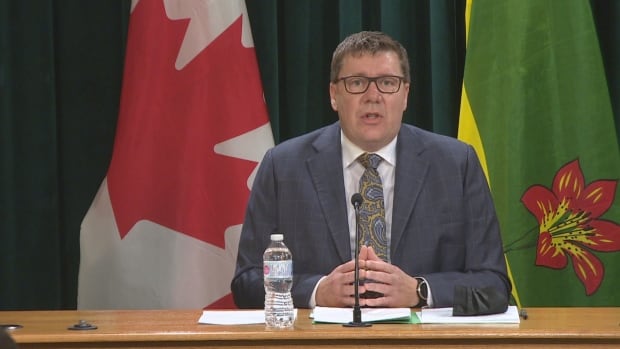The base rate fallacy and what Premier Scott Moe got wrong about COVID-19 spread in Sask. | CBC News
Experts are pushing back on Premier Scott Moe’s pronouncement earlier this week that vaccines no longer prevent the transmission of COVID-19.
Scientists and doctors say the premier’s position is not backed up by evidence or data.
“He’s spewing basically nonsense,” said Nazeem Muhajarine, a professor of epidemiology at the University of Saskatchewan.
In a statement published on Saturday, Moe wrote that “vaccination does not keep you from contracting COVID-19” and that “vaccination is not reducing transmission.”
Today, trucker rallies are being held at many locations across the country, including on Parliament Hill in Ottawa and in various communities in Saskatchewan. <br><br>Here is my message to Saskatchewan and Canadian truckers: <a href=”https://t.co/LifQ2FK23b”>pic.twitter.com/LifQ2FK23b</a>
—@PremierScottMoe
On Monday during a news conference, Moe modified his phrasing and repeated the claim.
Unaccompanied by any public health official, the premier said the data was clear to him.
“The bottom line of all of all of this is that vaccines do work, but they are no longer working at preventing transmission in this wave of COVID 19, like they previously did in the Delta wave at which they were quite effective,” said Moe.
Experts say that although the Omicron variant has lowered the effectiveness of vaccines in preventing transmission, that doesn’t mean they’re useless.
“[Vaccination] actually does reduce transmission significantly, particularly when a person has a booster,” said Angie Rasmussen, a virologist with the University of Saskatchewan.
Experts say the premier’s conclusion appears to be based on multiple misunderstandings.

Base rate fallacy
At the core of the premier’s apparent misunderstanding is that there are similar total numbers of unvaccinated and vaccinated people getting COVID-19.
“The new cases that we have in this province are are roughly about the same in vaccinated and unvaccinated people here in Saskatchewan,” Moe said earlier this week.
Take the number of COVID-19 hospitalizations that were reported by Saskatchewan on Wednesday, when 123 of the 372 hospitalized patients, or 33 per cent, were not fully vaccinated.
At first glance that figure may seem concerning, as that means 249 of those hospitalized people are fully vaccinated.
However, the data itself is misleading because its being presented in whole numbers, an issue CBC Saskatchewan previously addressed in August 2021.
Experts say the case numbers should always be viewed as numerators — the number above the line in a fraction — with the full population of unvaccinated, partially vaccinated, fully vaccinated or boosted people as denominators — the number below the line in a fraction.
As of Wednesday, 79.29 per cent of Saskatchewan’s eligible population has at least two vaccine doses. That’s more than 897,000 people.
In comparison there are approximately 234,000 eligible people who are not fully vaccinated.
When you view the hospitalization numbers as fractions for vaccinated and unvaccinated people, there’s very little in the way of comparison:
- Not fully vaccinated – 123 hospitalizations/234,000 people = approximately 53 per 100,000 people.
- Fully vaccinated – 249 hospitalizations/897,000 people = approximately 28 per 100,000 people.
“You’ve got to look at those denominators and the pool from which you’re drawing from in order to begin [understanding this],” said Dr. Alex Wong, an infectious disease specialist based in Regina.
Viewing the data as fractions better illustrates the true level of risk, experts said.
The premier’s decision to view the data as only whole numbers is what experts commonly refer to as a base rate fallacy.
But the base rate fallacy isn’t the only issue experts raised about the premier’s conclusion.
“It’s much more complex than that,” said Wong.

Messy data
The problem with using the base rate fallacy to debunk the premier’s statements is that the data the province is reporting is no longer accurate, said Wong.
The province says only people with significant or worsening cold or flu-like symptoms including fever, or those who are considered at-risk due to underlying health conditions, should get a PCR test to confirm their COVID-19 diagnosis.
Everyone else has been instructed to rely on the results of a self-administered rapid test.
That means many people who have COVID-19 are no longer being reported as part of the province’s case counts, making the province’s case numbers unreliable.
Someone having three doses of a vaccine also means they’re more likely to go get a PCR test, Wong said, although there’s no clear indication on how much that is skewing the data.
The messy data is a reminder that when scientists and experts look at data, they are always mindful of the limitations and caveats that are applied to the information.
Wong says Moe’s comment didn’t take any of that into account.
“[His conclusion was] not appropriate to make because of of the limitations and the challenges in interpreting the data,” Wong said.
LISTEN| How to protect yourself from COVID-19
10:34Medical column – How to protect yourself from Covid
Public health restrictions are loosening in Canada, so how do we keep ourselves and our families safe from COVID-19? We ask Dr. Peter Lin for tips. 10:34
Transmission
The Omicron variant’s increased infectiousness means that the immunity provided by vaccinations isn’t as powerful as it was during the Delta-driven fourth wave in Saskatchewan.
But that doesn’t mean it isn’t working, as stated by Premier Scott Moe.
Two doses is no longer sufficient, according to Muhajarine. Booster doses are now necessary as two doses are no longer as effective against the Omicron variant, he said.
“[It has] moderate effectiveness and that is pretty solid. It’s much better than some of the other vaccines that we give routinely,” Muhajarine said.

Rasmussen also called for everyone to get booster doses as quickly as possible.
“Some studies that have been done in the U.S. by the Center for Disease Control have showed that a booster shot actually increases protection against infection all the way up to about 60 to 70 per cent, depending on the study,” said Rasmussen.
All of the experts told CBC News that the premier’s comments are likely undermining the effort to get more vaccinations — especially booster doses — into arms.
Muhajarine said the premier’s comments undermine faith in public health and the effectiveness of vaccines.
“What he was saying this past few days is not policy. It is not science. He’s not a scientist and he knows that it should actually come out of … the chief medical health officer’s mouth” the epidemiologist said.
For all the latest health News Click Here

